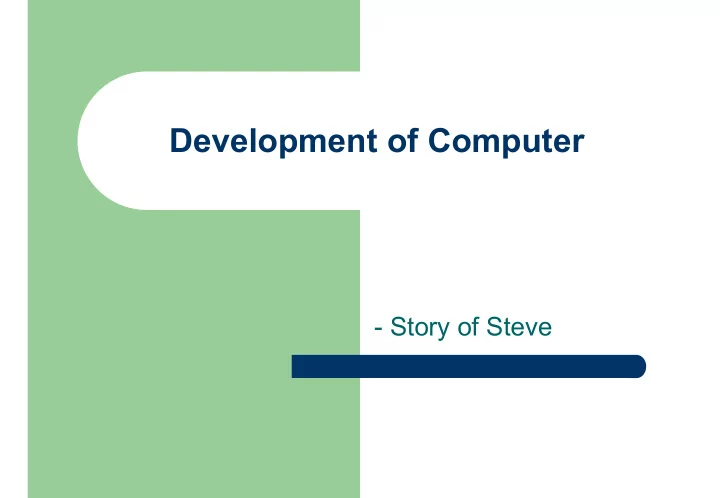

Development of Computer - Story of Steve
What is a computer � A high intelligence machine � A tool – make our life much convenient � A very loyal servant � Pretty dumb---why?
How computer works � Computer only manipulate binary numbers, a sequence of 1’s and 0’s, basically addition operation � You need to give computer very detail, very precisely commands, you need to define everything clearly in the computer language
PC XT 286 � ORIGIN U.S.A. � YEAR 1986 � SPEED 6 MHz � RAM 1 MB � CGA modes : 640 x 200 � HARD DISK: 40 MB
PC 386 – PC 486 - Pentium � ORIGIN U.S.A. � YEAR 1996 � SPEED 60 MHz � RAM 8 MB � SVGA modes :1024 x 768 � HARD DISK: 500 MB
Pentium 4 – Centrino (Pentium M) � Nowadays, what is the computer look like � The trend: – Smaller - Wireless – Faster - Artificial Intelligence – Portable - Embedded System – Power Saving - Big Memory – Reliable - Integrated
Moore's law � In 1965 Intel co-founder Gordan Moore noted that processing power (number of transistors and speed) of computer chips was doubling each 18 months or so. This trend has continued for nearly 4 decades. � It has been proved to be true in all the other computer science
Types of Languages � Computers require a method of instruction to operate,. Modern computers get their instructions from programming languages . � A programming language is an agreed-upon format of symbols that enables a programmer to instruct a computer to perform certain predefined tasks. � There are two types of languages depending on how understandable they are: high- and low-level languages .
The Development of Programming Languages � Manual switches using binary numbers � Assembly language � COBOL and FORTRAN – allowed programs to be run on another system than the original � C – originally used for developing operating systems, but became very popular � C++ and other object-oriented languages – enabled creation of reusable programs � Java – like C++, but can be run on any computer without recompiling
Interpreters, Compilers, and JITs � High-level languages like Visual Basic .NET must be converted into a language the machine understands before it can execute it. There are three main methods for accomplishing this task: Interpreting. An interpreter is a program that converts the � language at the time the application is executed. This leads to slow executing applications. Compiling. A compiler will perform all of the translation at � once and store the results in a file called an executable . This results in a faster execution but one which is compiled for a specific computer chip. Just-in-time compiling ( JIT ). JIT compilers compile the source � code into an intermediate language which is then translated just in time to be executed by the computer. Visual Basic .NET and Java use this method.
Recommend
More recommend